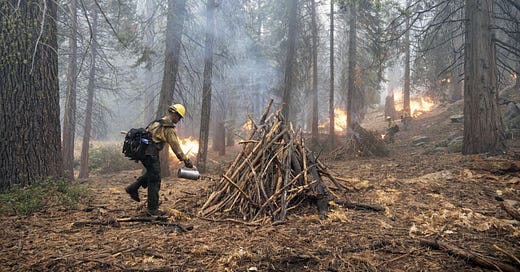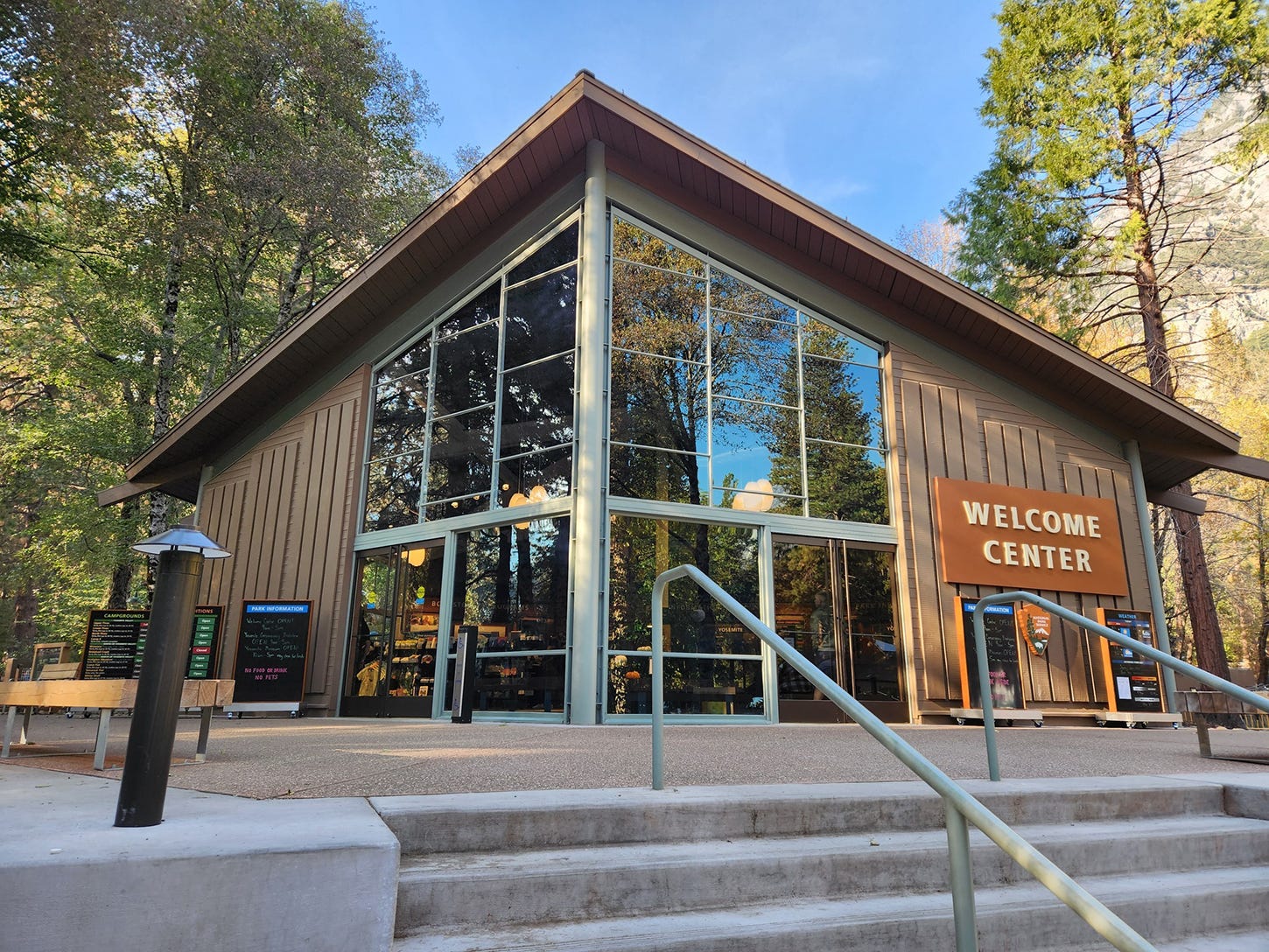Volume 2, Number 27 - Thursday, Nov. 9, 2023
Published twice a week, on Monday and Thursday
Perspective
I DON’T HAVE AN ANSWER to the burning question here – is there more or less burning going on in the Sierra Nevada?
In terms of what most people would call destructive wildfire, it’s pretty obvious there has been less in the past two years than the five or so years before.
But what about what some call beneficial fire — prescribed burning and pile burning?
I’ve been poking around the Internet to see what current statistics might be out there but haven’t had success yet. CalFire’s website is a little wonky, and if there’s a central source with such information, I haven’t found it yet.
My own sense is that there has been lots of planning for prescribed fire, but keeping track of what projects take place is challenging. I hope to track down some statistics eventually.
I’m also interested in what I may learn from a newly published book by journalist M.R. O’Connor with the intriguing title “Ignition.” I’m trying to decide whether to order a hardback or read it on my Kindle. O’Connor writes about the politics and ethics of science, technology, and conservation; this is her third book.
In an article on the website Undark, with the headline: “How America’s Forest Fire Revolution Lost Its Spark,” the author discusses the early days of prescribed fire in Yosemite and Sequoia and more.
You can learn more about the book HERE and read the Undark article HERE. Here’s an excerpt from the article:
Jennifer Mueller of the nonprofit organization the Ember Alliance told me that today we urgently need an “army of fire practitioners.” Creating one would require another reimagining of fire’s place in American life — like the one that occurred in 1962. “By that I mean planning for wildfires, doing community protection, cooperative burning with federal and nonfederal sources, creating good, blue-collar jobs at scale,” said Mueller.
News reports run the gamut as to whether there has been more — or less — prescribed fire in California.
On Oct. 10, KQED published a piece HERE titled “This Was a Good Year for Prescribed Burns. Why Didn't California Do More?” In the article, UCLA climate scientist Daniel Swaim explained that weather conditions must be just right.
But, he added, “Most days this year that were favorable for it, there really wasn’t much prescribed fire activity.”
Yesterday, CapRadio reported “With more rain and fewer fires, California forests saw more prescribed burns this year.” The story focused on the Lake Tahoe area and didn’t provide much data. Check it out HERE.
Pile burning
The photo above is from Sequoia and Kings Canyon National Parks. It was published on Facebook with a note that “visitors to the Grant Grove area this week may notice the Big Stump East Pile Burns, which are taking place southeast along Highway 180 as it enters Kings Canyon National Park. The section of the Big Stump Trail that goes through this area is closed during this project, but there are minimal other impacts to visitors.”
The NPS explained that “pile burning is a routine operation used to eliminate excess vegetation that has been cut and piled to make the forest healthier. Firefighters gather dead and down wood and cut small trees and brush into large piles. These piles are later ignited and allowed to consume. This leaves a less dense forest stand with less accumulated dead vegetation on the ground, which is healthier for the forest, and also makes it less vulnerable to potentially dangerous wildfires in the future.”
Pile burning is not the same as prescribed fire, sometimes called broadcast burning, as I noted HERE, in a newsletter published in February.
I’m curious about what response I may get to a question I sent to Sequoia National Forest earlier this week. In a news release you can read HERE, the Forest Service reported that pile burning within the Western Divide Ranger District’s Trail of 100 Giants is planned this week as part of the giant sequoia emergency response.
According to the news release, crews have reduced fuels on more than 1,500 acres in 11 Sequoia National Forest groves, over 4,400 giant sequoias have been treated, and more than 7,600 piles have been prepared for prescribed burning.
I reported in a newsletter published last March (read it HERE) that SQF’s efforts to burn some 7,500 piles of vegetation created last summer and fall will continue as weather and other conditions allow.”
In late February, Gretchen Fitzgerald, ecosystem staff officer of Sequoia National Forest and Giant Sequoia National Monument, said that workers have burned more than 2,200 piles in three of the groves — and about 5,400 piles remain.
So my question to SQF was whether the 7,600 piles discussed in the latest news release include any of the piles created in the previous season and how many of the 5,400 piles remaining in February might be part of the new count.
I’ll let you know what I find out.
About that ancient four-foot-tall oak tree
On Monday, I wrote about the Jurupa Oak in Riverside County, which may be thousands of years older than giant sequoias. I’ve learned much more about the tree and how ages are calculated, and I’ll share it next Monday.
Free admission for veterans at Calaveras Big Trees State Park
Calaveras Big Trees State Park offers free admission for veterans and active and reserve military on Veterans Day, Saturday, Nov. 11.
New Yosemite Valley Welcome Center open
A new Yosemite Valley Welcome Center has opened in Yosemite National Park. This facility is the hub for visitor orientation, staffed by park rangers and volunteers. A bookstore operated by the Yosemite Conservancy is part of the center. It is part of the Village Store complex adjacent to the central parking lot for convenience and has a nice view of Glacier Point. The new welcome center is open from 9 a.m. to 5 p.m. daily. The old Yosemite Valley Visitor Center will be transformed into the new Yosemite Exploration Center.
The welcome center and forthcoming Yosemite Exploration Center are partly funded by Yosemite Conservancy donors.
Sierra Club webinar this evening will discuss forest crisis and ‘when to oppose and when to support’ National Forest projects
A webinar sponsored by the Sierra Club Tahoe Area Group is set from 5:30 p.m. to 6:30 p.m. this evening. The virtual presentation is entitled: Why are Sierra Nevada Forests in Crisis? What Can Activists Do? The speaker will be John Buckley, director of Central Sierra Environmental Resource Center.
Here’s an excerpt from the promotional notice:
Over the years, national forest management policies for the Sierra Nevada region have markedly changed. There are key reasons. Many activists may not be aware that, in some instances, public forest logging, biomass removal, and other mechanical forest treatments can be positive instead of negative. This PowerPoint presentation can enable activists can be more effective at knowing when to oppose and when to support national forest projects. The presentation will be filled with compelling and often dramatic photos. John is a long-time leader with the Tuolumne Group of the Sierra Club for the Northern Yosemite region. He brings many years of experience from working as a Hot Shot firefighter and serving as an activist on the front lines for many regional conservation issues.
You can sign up for the webinar HERE.
Wildfire, water & weather update
More snow in the Sierra Nevada from the recent storm, including in the Upper Tule area, where many giant sequoias grow and to the north. At Yosemite National Park, Tioga and Glacier Point roads are temporarily closed due to snow and ice, but Glacier Point Road may reopen this afternoon. Snow is expected at higher elevations in Sequoia and Kings Canyon National Parks later today. Calaveras Big Trees State Park is expected to get more rain later in the week. The best Sierra Nevada weather forecasts are at NWS Hanford, HERE, and NWS Sacramento, HERE.
Wildfire update: Prescribed burning, including pile burning, continues at many locations in the Sierra Nevada, as weather and other conditions allow. If you check out the WatchDuty map HERE you’ll see a string of green flame icons where prescribed burning is reported to be underway.
Last week, Calaveras Big Trees State Park advised that the long-awaited South Grove prescribed burn has been postponed due to recent wet weather — and more rain is on the way later this week.
Did you know you can comment here?
It’s easy to comment on items in this newsletter. Just scroll down, and you’ll find a comment box. You’re invited to join the conversation!
Giant sequoias in the news
• There’s an interesting story in the Sacramento Bee this morning about tree climbers who harvest seeds from California’s conifers — pines, firs, cedars and redwoods. Unfortunately, no gift link is offered, but you may be able to read it HERE. And an excerpt:
These climbers are also the linchpin in California’s new plan to save scorched forests from disappearing, threatened by mega-fires made worse by poor forest management and climate change.
Gov. Gavin Newsom’s Forestry and Fire Task Force found that 1.5 million acres of California forest were scorched by 70% high-severity fire during the 2019-2021 fire seasons, according to an internal estimate shared with The Bee. Fire devastation on those acres is so intense that trees won’t naturally grow back, and to prevent them from becoming shrubby chaparral, they need to be replanted. But reforestation at this scale is no small feat, mainly because the state lacks the capacity to get it done.
Foresters say bringing back California’s “reforestation pipeline” — the network of seed banks, nurseries and planting operations — is desperately needed. Meeting the state’s target would require around 300 million new trees and closer to 500 million conifer seeds, five times what was collected last year, according to calculations based on industry estimates. Tree planting costs alone would cost around $1.5 billion.
* KQED has a piece HERE about production of a short film called Reforestation. The film includes tree-climbers, footage of past fires and related interviews. You can watch the film HERE. It disturbed me to see at the beginning that the community of Dorrington was labeled as being in the Southern Sierra, but otherwise, the film was informative and interesting. (Dorrington is in Calaveras County, quite a bit north of the Southern Sierra Nevada).
Thanks for reading!





